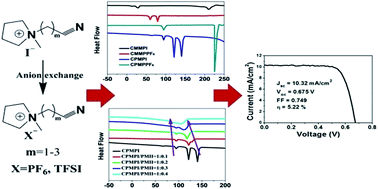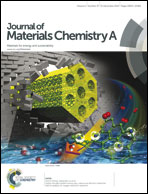Design and synthesis of functional ionic liquids based on pyrrolidinium cations bearing alkyl nitrile moieties†
Abstract
A series of functional ionic liquids based on pyrrolidinium cations bearing alkyl nitrile moieties have been designed, synthesized and characterised with high purity and yield. The influence of the anion structure and methylene chain length of the alkyl nitrile moieties on the thermal properties of functional ionic liquids is comprehensively investigated. Moreover, some of the ionic liquids show obvious plastic crystal phase behavior with rotational disorder and activated vacancies/defects, which can offer a solid bulk matrix for doping 1-propyl-3-methylimidazolium iodine (PMII), LiI and I2 to prepare plastic crystal electrolytes with high melting points and conductivities. Furthermore, the resulting solid-state dye-sensitized solar cell (DSSC) exhibits a power conversion efficiency (PCE) of 5.22% under the simulated air mass 1.5 solar spectrum illumination at 100 mW cm−2, and displays a superior long-term stability compared to conventional liquid-based devices. These results offer us a feasible method to explore new organic plastic crystals and electrolytes for high temperature solid-state DSSCs.


 Please wait while we load your content...
Please wait while we load your content...